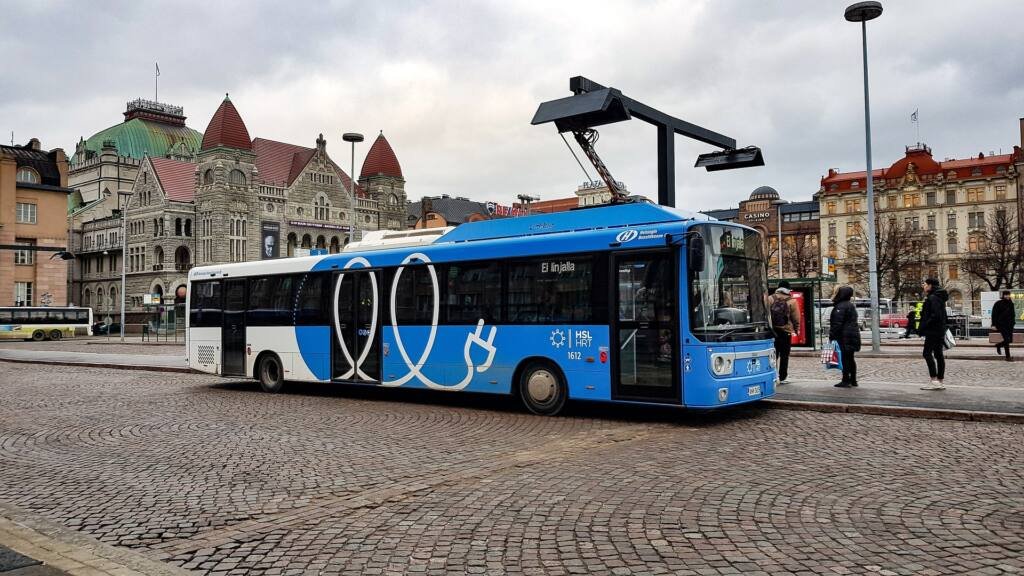Emission-free commuting, a concept that balances the demands of contemporary mobility with the urgency of environmental preservation, has emerged due to the search for environmentally acceptable transportation options. EV buses are at the vanguard of this movement, set to transform urban travel by removing hazardous emissions and revolutionizing public transit.
Modern battery technologies are used to power EV buses, which represent the shift to sustainable transportation. These electric-only buses offer a significant step toward cleaner air and smaller carbon footprints in the world’s busy cities because they have no exhaust emissions.
This investigation examines the world of emission-free transportation using EV buses as a focal point. This article will examine these vehicles’ inner workings and illuminate the systems enabling their emission-free travel.
It will also highlight EV buses’ numerous advantages, like increased comfort and environmental awareness, while reducing operating costs and improving air quality and noise levels.The progress in incorporating electric buses into urban infrastructure is notable, even though the path to a completely electric transportation landscape is challenging.
Join the discussion as you explore the present and future of emission-free transportation and see how electric buses pave the way for cleaner, quieter, and more sustainable communities.

Technological Advances in EV Buses: Toward a Sustainable Future
EV buses have become trailblazers in the rapidly changing field of sustainable transportation, transforming urban mobility and reducing emissions. The idea of emission-free public transportation is becoming a reality due to significant breakthroughs in electric bus technology that increase their performance and extend their range.
The development of battery systems has been one of the most important developments in electric bus technology. Due to its short range and lengthy charge periods, lithium-ion batteries were once considered a drawback.
Innovative battery chemistries, such as lithium iron phosphate (LiFePO4) and solid-state batteries, have shortened charging periods and increased the driving range of electric buses. These developments have reduced range anxiety, a significant barrier to adopting electric vehicles, and improved operational efficiency.
Another area that is undergoing transformational change is the infrastructure for charging. Fast-charging locations with high-power chargers are becoming essential to operating electric bus networks. These chargers allow buses to run effectively and continuously throughout the day by quickly charging a sizable amount of the battery.
Additionally, the technology known as bidirectional charging, which enables electric buses to discharge energy back into the grid during times of high demand, has the potential to transform urban energy management completely.
Smart Technologies Are Also Shaping the Future of Electric Buses
Fleet operators can now optimize routes, keep track of battery health, and anticipate maintenance requirements thanks to the development of Internet of Things (IoT) devices and real-time data analytics. This guarantees smooth operations and lengthens the life of the buses, improving the system’s overall sustainability. For electric buses as well, autonomous driving capabilities are short. Autonomous electric buses have been undergoing controlled environment testing while not yet being widely used. These vehicles could herald a new era of public transit by increasing safety, effectiveness, and traffic flow.
The World of Electric Bus Technology is Changing Quickly and Inevitably
Electric buses are on the verge of attaining previously unheard-of levels of effectiveness, performance, and environmental impact thanks to a convergence of cutting-edge batteries, quick-charging infrastructure, intelligent technology, and the potential for autonomous operation. Electric buses are brilliant examples of how innovation may pave the way for a cleaner and greener future as communities worldwide emphasize sustainable transportation.
Benefits of Commute with Electric Buses: A Greener and More Efficient Trip
Electric buses have become a game-changer in the fight for sustainable urban mobility, providing many advantages beyond conventional transit.
The benefits of electric buses for commuting have positioned them as game-changers in public transportation as cities struggle with air pollution, traffic jams, and the urgent need to decrease carbon emissions.
- Environmental Advantages
- The ability of electric buses to significantly cut greenhouse gas emissions and air pollutants may be the strongest case in favor of them. Electric buses have no tailpipe emissions, in contrast to their counterparts that are fueled by fossil fuels. This one change has the potential to drastically raise air quality and reduce the health hazards brought on by polluted city air.
- Economic Viability
- Electric buses may initially cost more than conventional buses, but the long-term financial advantages are significant. Due to the lower cost of energy compared to diesel or gasoline, electric buses have cheaper operational expenses. Moreover, their streamlined drivetrains result in lower maintenance costs due to fewer moving parts and don’t need oil changes.
- Reduced Noise Pollution
- The silent operation of electric buses significantly reduces noise pollution in cities. This not only improves commuters’ quality of life but also helps to make cities more tranquil and livable.
- Enhancing Public Health
- Electric buses may enhance public health by decreasing airborne pollutants and removing tailpipe emissions. Lessening one’s exposure to toxic compounds like nitrogen oxides and particulate matter can help prevent respiratory diseases and other difficulties.
- Improved Comfort
- Because they use electric drivetrains, electric buses provide a quieter and smoother ride. This may result in passengers having a more enjoyable commute, encouraging them to use public transit more frequently.
- Policies and Incentives
- Many municipal and state governments are providing incentives to promote the usage of electric buses. These incentives include tax exemptions, grants for charging infrastructure, and subsidies for buying electric buses. Such measures hasten the switch to a more environmentally friendly public transportation system.
- Branding and Image
- Cities that support electric buses show their dedication to environmental protection and sustainability. Adopting electric buses can improve a city’s reputation and draw visitors and locals who care about the environment.
- Climate Change Mitigation
- The transportation industry, which produces significant carbon emissions, is crucial in the fight against climate change. Cities may drastically cut their carbon footprint and support international efforts to curb global warming by switching out conventional buses with electric ones. Electric buses stand out as a ray of light in the vast effort to achieve sustainable urban life, solving environmental issues, boosting economic efficiency, and providing a more relaxing and health-conscious commuter experience. Cities go closer to having quieter streets, cleaner air, and a better future for everyone with each electric bus that enters service. Integrating renewable energy sources into the infrastructure for electric bus charging. Incorporating renewable energy sources into numerous sectors is gaining traction as the globe rushes towards a more sustainable future. The transportation industry, specifically the infrastructure for recharging electric buses, is one such area going through a dramatic transition. An innovative step towards greening public transportation networks and lowering their carbon footprint is the combination of renewable energy, in essence, solar and wind power, with electric bus charging.
- Solar-Powered Charging Stations
- With its limitless supply and low environmental effect, solar energy has emerged as a ray of hope for environmentally friendly infrastructure. Electric bus charging stations powered by the sun are cutting-edge technology that charges vehicles and sends extra energy to the grid. These charging stations use photovoltaic panels carefully placed atop canopies or near roads to capture sunlight. The electric buses are then charged using the collected solar energy, which reduces the need for conventional energy sources. Scalability is a major benefit of solar-powered charging. Charging stations can be incorporated into the existing urban infrastructure without additional room. Additionally, extra solar energy produced during off-peak hours can be redirected into the grid to help meet energy demands during periods of high demand. Balancing the grid makes the electricity supply more steady and dependable.
- Riding the Winds of Change: Using the Wind to Charge
- Another renewable energy source, wind power, is making its way into the landscape of electric bus charging. Wind turbines are used at wind-powered charging stations to produce electricity, which is used to charge the buses. The best locations for these turbines are next to bus stops or along routes with reliable wind patterns. The complementing nature of electric bus charging helps reduce wind generation’s intermittent nature. Buses can be charged with abundant wind resources, offering a flexible option that optimizes energy utilization. Furthermore, wind-powered charging stations have the potential to become famous monuments that demonstrate a dedication to environmentally friendly behavior and work as teaching resources for local communities.
- Renewable Energy Synergy: A Better, Greener Future
- The fusion of two renewable energy sources is embodied in incorporating solar and wind electricity into the infrastructure for charging electric buses. A healthy equilibrium is achieved as solar power flourishes in daylight and wind power does so at various times of the day. Bus charging is made possible by this complementing relationship, which lessens reliance on non-renewable energy sources and guarantees a steady and predictable energy supply. Such integration has numerous advantages. Among the benefits are a real step toward energy independence and reducing fossil fuel dependence and greenhouse gas emissions. Additionally, these cutting-edge charging options motivate and inform communities about how renewable energy can help create a cleaner and more sustainable future. A significant development in environmentally friendly transportation may be seen in integrating solar and wind energy into the infrastructure for charging electric buses.
These innovations serve as examples of how innovation may pave the way for cleaner air, lower emissions, and a more secure energy future as cities work to decarbonize their public transportation networks.
Electrifying Urban Transit: EV Buses as Catalysts for Sustainable Urban Planning and Traffic Relief
The need for sustainable urban planning is more important than ever in the dynamic fabric of contemporary cities, where urbanization and population expansion are constant threads. Electric buses have emerged as a transformational feature that easily weaves into the fabric of sustainable urban development amidst the complex task of reducing traffic congestion and limiting emissions.
- Air Pollution and Emissions Reduction
- An intelligent move toward greener, more breathable cities is the rise of electric buses. Buses using conventional internal combustion engines produce substantial air pollution, endangering human health and the environment. These worries are eased by electric buses, which have zero tailpipe emissions. In line with the fundamental ideas of sustainable urban planning, just one change results in better air quality and a healthier urban environment.
- Reducing Noise for Quieter Streets
- Urban streets echo with the buzz of internal combustion engines, which is a telltale sign of traffic jams. The near-silent functioning of electric buses offers a peaceful remedy to this sonic chaos. These buses help with noise reduction, improving the quality of life for locals and harmonizing with sustainable urban planning objectives of creating livable, calm urban environments as they glide through neighborhoods without the roar of engines.
- Support of Public Transportation and Congestion Reduction
- Introducing electric buses complements initiatives to encourage the use of public transit, which will reduce traffic congestion. Furthermore, it is an environmentally friendly method of transportation that helps reduce the number of cars on the road; electric buses present an appealing substitute for personal vehicles. Electric buses are emerging as essential elements of a comprehensive transportation network as urban planners try to improve mobility and lessen congestion.
- Livability and Urban Aesthetics
- Beyond functional factors, sustainable urban planning also considers a city’s aesthetics and livability. Modern towns’ aesthetics are enhanced by electric buses since they provide an image of innovation and environmental awareness. These buses go through urban areas to demonstrate dedication to lowering carbon emissions, which locals and tourists receive well.
- Synergies in Infrastructure
- Infrastructure for charging electric buses must be created for them to be integrated. This infrastructure can then be created to support a variety of environmentally friendly transportation options. A comprehensive approach to urban mobility can be supported by sharing electric bus charging stations with electric cars and bicycles. This coordination of modes of transportation is in line with sustainable urban design techniques that support seamless connection and multimodal transit.Electric buses are a powerful ally for sustainable urban design in a world where traffic congestion and environmental issues present complicated problems. Electric buses work harmoniously to build livable, dynamic communities by decreasing emissions, limiting noise pollution, and encouraging public transit usage. Electric buses represent a hopeful mix of contemporary transportation and environmentally friendly cityscapes as they travel clean, energy-powered routes.
Forging a Green Partnership
Collaboration is the key to success in the field of sustainable transportation. It is a credit to the effectiveness of cooperation between governments, public transportation agencies, and private sector businesses that there has been such a significant movement toward EV buses as the cornerstone of environmentally responsible mobility.
This coordinated effort has accelerated the usage of EV buses and ushered in a new era of cleaner, more effective urban transportation networks.
- Frameworks for Policy and Incentives
- Governments are crucial in laying the groundwork for the use of electric buses. They create an atmosphere encouraging public transportation agencies and private sector businesses to participate in electric bus fleets. This can be achieved by formulating strong policy frameworks and offering incentives. Governments use various tools to speed up the transition, including grants for charging infrastructure, tax incentives, and subsidies for buying EV buses.
- Infrastructure Development
- Creating a charging infrastructure is essential to the wide-scale usage of EV buses. Here, cooperation between public transit providers and businesses operating in the private sector is essential. Private enterprises provide their technical prowess in designing and implementing effective charging solutions, while agencies bring their knowledge in urban transit and operational requirements. The planned placement, comprehensive equipment, and smooth integration of charging stations into the current transportation infrastructure are all made possible by this innovative alliance.
- Technology Advancements and Innovation
- Private sector businesses, frequently at the forefront of technical innovation, contribute significant developments. These advancements, whether they include creating more effective battery systems, cutting-edge energy management technologies, or data analytics for route optimization, increase the effectiveness and viability of electric buses. These technologies may be tested and improved in real-world settings thanks to cooperation with public transportation organizations, guaranteeing that they satisfy urban mobility needs.
- Financial Sustainability
- Although using electric buses promises significant long-term savings, it requires upfront expenditure. Collaboration between all parties involved becomes crucial at this point. Governments and public transportation organizations can get funding, while private businesses can provide vehicles and charging infrastructure at competitive prices. A viable economic model that balances the early costs with long-term operational gains emerges from this financial engagement.
- Engagement and Acceptance in the Community
- Any sustainable effort must have the backing of the community to succeed. Public transportation providers, private businesses, and governments work together to educate the public about electric buses’ advantages and ease their worries. Transparent communication promotes comprehension and increases trust, which opens the door for easier transitions and favorable public opinion. Collaboration takes the lead in the grand symphony of sustainable urban transportation. Governments control the baton, directing incentives and policies. Public transit organizations provide the smooth orchestration of activities. Private sector businesses provide cutting-edge infrastructure and technologies. Their collective adoption of electric buses ushers in a cleaner, quieter, and more sustainable future for urban transit.
Conclusion: Paving the Way to Greener Cities Through EV Buses
In an era where the intertwining threads of urbanization and environmental preservation demand innovative solutions, electric buses emerge as a transformative force for sustainable urban development. With a resolute commitment to cleaner air, reduced congestion, and diminished emissions, these buses epitomize the essence of eco-friendly commuting.
The journey through the world of electric buses reveals a landscape undergoing rapid transformation. From battery breakthroughs that extend range and shorten charging times to the evolution of charging infrastructure, the technological strides are impressive. Smart technologies, potential autonomous capabilities, and the harmonious marriage of solar and wind power further redefine urban transportation possibilities.
The benefits of electric buses extend far beyond their quiet, emission-free journeys. They reshape the very fabric of cities, combating air pollution, lowering noise levels, and invigorating public health. These buses catalyze change, not just in urban design, but also in attitudes and behavior, forging a greener, more harmonious urban existence.
Yet, progress isn’t without its challenges. Collaborative efforts among governments, private sector innovators, and public transit agencies have illuminated the path forward. Policy frameworks, incentives, technology advancements, and community engagement form the pillars supporting the transition to a cleaner, more efficient, and interconnected transportation network.
As electric buses navigate the streets, they paint a portrait of a promising urban future. The symphony of collaboration harmonizes aspirations into tangible realities. With every electric bus that graces the roads, the vision of greener cities, quieter streets, and healthier communities draws nearer. Through unwavering partnership, electric buses propel us toward a future where sustainability and urban life coalesce in perfect harmony.








